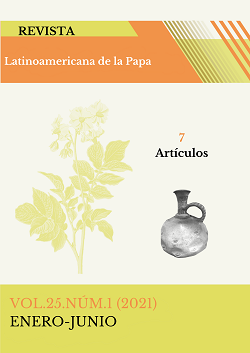Effect of Biostimulants on potato (Solanum tuberosum L.) production for the Totora area in Cochabamba, Bolivia
##plugins.themes.bootstrap3.article.main##
Abstract
In order to evaluate the effect of Biostimulants on potato (Solanum tuberosum L.) production in Totora, Cochabamba, experimental plots were implemented with the seed company SEPA. The field trials were implemented in an experimental design of Completely Randomized Blocks (DCRB) with subsampling and four repetitions. Six treatments were implemented: T1: Control (without application), T2: Tricobal (applied to the seed), T3: Fostop (applied to the seed), T4: Energy top (applied to the seed), T5: Maxim SEPA (Fludioxonil and Metalaxil-M) to the seed + Energy Top (applied to the foliage) and T6: Maxim SEPA (Fludioxonil and Metalaxil-M) to the seed + Tricobal (applied to the foliage). The results showed that there was a high and positive correlation between chlorophyll content and yield. This suggests that the variables are not independent, and biostimulants affect photosynthesis. It was observed that the higher the chlorophyll content in the leaves, the yield increases on average. The best treatments were for T6 (Maxim to the seed + Tricobal applied to the foliage), with a yield of 30 t/ha and Energy top with 26 t/ha, with the highest numbers of tubers per plant and the highest Marginal Return Rate (Bs 24.31).
Additional keywords: Photosynthesis, chlorophyll, treatments, marginal rate of return, variables
Download Statistics
##plugins.themes.bootstrap3.article.details##

This work is licensed under a Creative Commons Attribution-NonCommercial-ShareAlike 4.0 International License.


 https://orcid.org/0000-0001-8146-2968
https://orcid.org/0000-0001-8146-2968